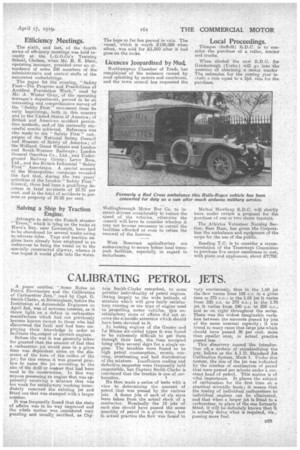CALIBRATING PETROL JETS.
Page 7

If you've noticed an error in this article please click here to report it so we can fix it.
A paper entitled. " Some Notes on Petrol Flow meters and the Calibration of Carburetter Jets," read by Capt. G. Smith-Clarke, at Birmingham, before the Institution of Automobile Engineers on April 3rd, was of extreme interest, as it threw light on a defect in carburetter manufacture which had not preViously become known except to these who had discovered the fault and had been employing their knowledge in order to facilitate theeoutput of aircraft engines.
Before the war it Wag generally taken for geanted-thatthe amotintof fuel that a carburetter jet would pass in is given time was dependent. alone on the diameter of the bore of the orifice of the jet ; for this reason it was general practice to name the jet according to the size of the drill or roamer that had been used in its construction. In this way anyone possessing an engine that was apparentiy receiving a mixture that, was tee weak for satisfactory working immediately removed the existing jet and fitted one that was stamped with a larger number.
It was frequently found that the state of affairs was in no way improved and the whole matter was considered very puzzling and usuallyascribed, as Cap tain Smith-Clarke remarked, to some peculiar individuality of petrol engines. Owing largely to the wide latitude of mixture which will give fairly satisfactory running in. zee type of engine used in propelling motor vehicles this' unsatisfactory 'state of affairs didnot receive the scientific attention which should have been devoted to it.
In testing engines of the Gnome and Le Rhone air-cooled types it was found to be extremely difficult to get them through their test, the time occupied being often several ela,ys for a single engine. The troubles were found to be high petrol consumption erratic running, overheating and ael distribution of the mixture. Insufficient cooling and defective magnetos were frequently held responsible, but Captain Smith-Clarke is convinced that the trouble is one of carburation.
Be then made a series of tests with a view to . determining the amount of petrol that Was passed by the various jets. A dozen jets of each of six sizes were taken from the actual' stock of a contraetor. Nominally the 12 jets of each size should have passed the same quantity of petrol in a given time, but in actual practice the flow was found to
vary enormously, thus in the 1.60 jet the flow varies from 195 c.c. in a given time to 275 c.c. ; in the 1.65 jet it. varies from 230 c.c. to 270 c.c. ; in the 1.70 jet it varies from 240 c.c. to 290 c.c., and so on right throughoutthe series. There was the widest imaginable variation between the amounts passed by jets of the same nominal capacity; it was found in many cases that large jets which should have passed 30 per cent, more than smaller ones, in actual practice passed less.
This discovery caused the introduction ofea system of standardizing the jets. kilbwn as the A.I.D. Standard Jet Calibration System' Mark 1. Under this system, the size of the jet was indicated by the number of centimetres of petrel that were passed per minute under a constant head of petrol. This matter is of vital importance. It places the subject of carburation for the first time on a practical scientific basis; it means that the tuning of individual carburetters to individual. engines can be eliminated, and that when a larger jet is fitted to a carburetter, in place of the one formerly fitted, if will be definitely known that it is actually doing what is required, viz., passing more fuel.






















